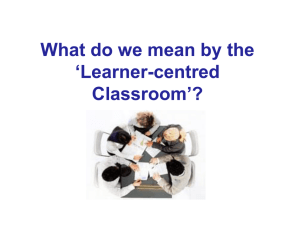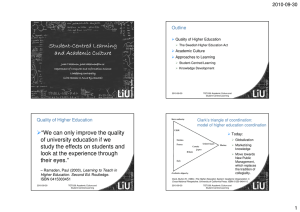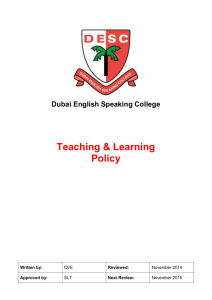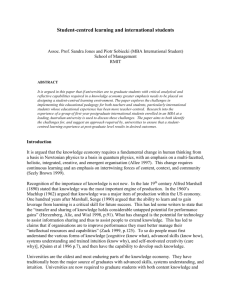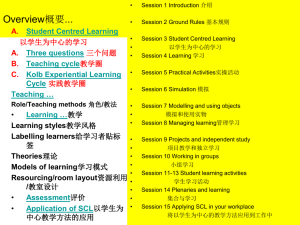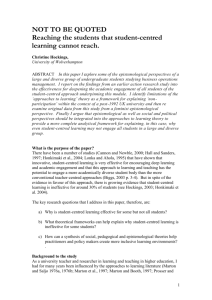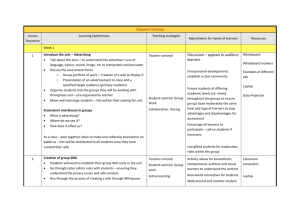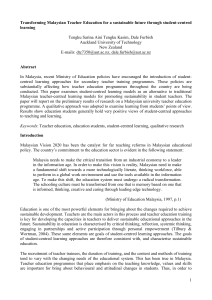student centred learning – a practical guide for teachers
advertisement
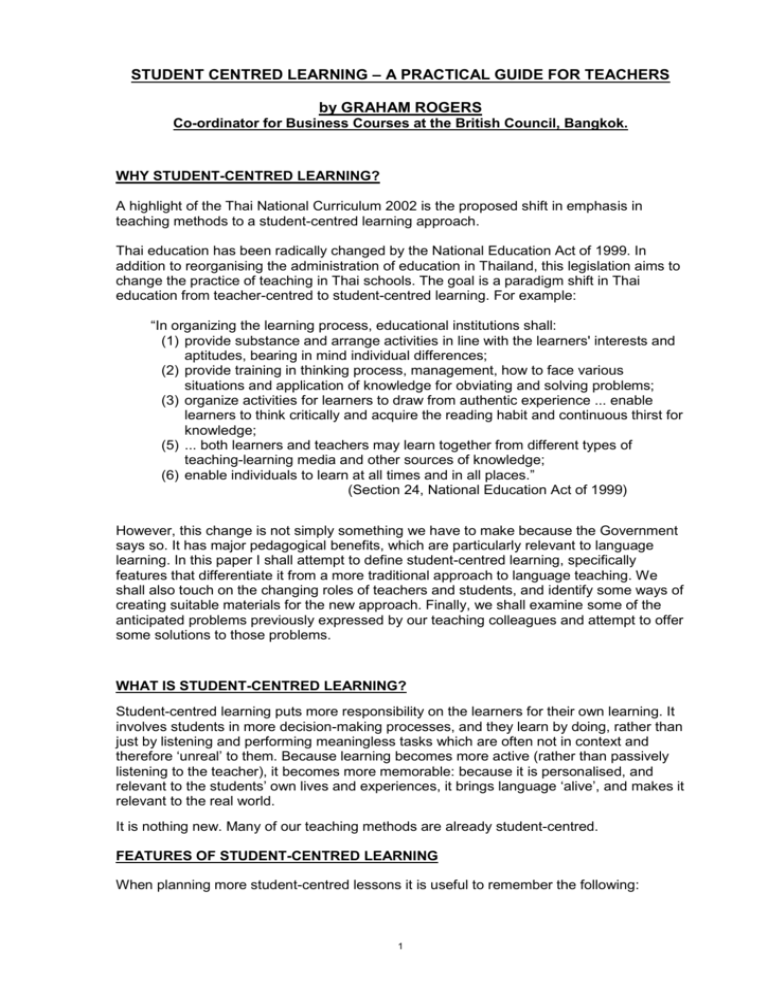
STUDENT CENTRED LEARNING – A PRACTICAL GUIDE FOR TEACHERS by GRAHAM ROGERS Co-ordinator for Business Courses at the British Council, Bangkok. WHY STUDENT-CENTRED LEARNING? A highlight of the Thai National Curriculum 2002 is the proposed shift in emphasis in teaching methods to a student-centred learning approach. Thai education has been radically changed by the National Education Act of 1999. In addition to reorganising the administration of education in Thailand, this legislation aims to change the practice of teaching in Thai schools. The goal is a paradigm shift in Thai education from teacher-centred to student-centred learning. For example: “In organizing the learning process, educational institutions shall: (1) provide substance and arrange activities in line with the learners' interests and aptitudes, bearing in mind individual differences; (2) provide training in thinking process, management, how to face various situations and application of knowledge for obviating and solving problems; (3) organize activities for learners to draw from authentic experience ... enable learners to think critically and acquire the reading habit and continuous thirst for knowledge; (5) ... both learners and teachers may learn together from different types of teaching-learning media and other sources of knowledge; (6) enable individuals to learn at all times and in all places.” (Section 24, National Education Act of 1999) However, this change is not simply something we have to make because the Government says so. It has major pedagogical benefits, which are particularly relevant to language learning. In this paper I shall attempt to define student-centred learning, specifically features that differentiate it from a more traditional approach to language teaching. We shall also touch on the changing roles of teachers and students, and identify some ways of creating suitable materials for the new approach. Finally, we shall examine some of the anticipated problems previously expressed by our teaching colleagues and attempt to offer some solutions to those problems. WHAT IS STUDENT-CENTRED LEARNING? Student-centred learning puts more responsibility on the learners for their own learning. It involves students in more decision-making processes, and they learn by doing, rather than just by listening and performing meaningless tasks which are often not in context and therefore ‘unreal’ to them. Because learning becomes more active (rather than passively listening to the teacher), it becomes more memorable: because it is personalised, and relevant to the students’ own lives and experiences, it brings language ‘alive’, and makes it relevant to the real world. It is nothing new. Many of our teaching methods are already student-centred. FEATURES OF STUDENT-CENTRED LEARNING When planning more student-centred lessons it is useful to remember the following: 1 Ask don’t tell: always try to elicit information, ideas, and answers from the students. They are not empty vessels waiting to be filled by the all-knowing teacher. They have knowledge and experiences of life, as well as language which can contribute greatly to the learning process. The more they contribute, the more they are likely to remember. We should never underestimate the ability of our students. Focus on students’ experience and interests: if the teacher chooses the topic, or just follows the course book, the students may not be interested. If, however, teachers use the course book as a base for then moving on to practice activities relating to the students' personal lives and areas of interest and experience (personalisation), the students are more likely to become involved in the lesson, thereby remembering more. Communication over accuracy: the main reason for students learning a language is to be able to communicate with other speakers of that language. In reality they will probably speak English with more non-native speakers from the region than with native speakers, and the ultimate goal is to be able to understand and respond to each other. Students therefore need opportunities to practise communicating in English without the constant fear of making mistakes hanging over them. If you feel the need to correct their mistakes, don't interrupt their conversations, make notes and give feedback later. Learning by doing: the more actively involved students are in their own learning, the more they are likely to remember what they learn. Students have choices and make decisions about learning. Group work requires negotiation and decision making – working together towards a common goal. Focus on confidence building for real-world skills. By developing communicative competence, language again becomes more ‘real’ and part of the students’ lives. Encourage interest in English used in the real world. By using authentic materials familiar to the students (magazines, the internet, video, television, letters etc.), students are constantly in touch with the language in an absorbing way. Tasks are open-ended, i.e. there is more than one possible answer. Traditional grammar based tasks are either right or wrong and test only one skill at a time. They are generally unimaginative, often in the form of multiple choice answers (so the students have a 25% chance of being right without actually knowing the answer at all) and totally divorced from ‘real world’ situations. Open-ended tasks are wider in their focus and involve a variety of language skills. High exposure to English through the use of authentic materials again: students may be set homework involving research undertaken using the internet or other English language reference sources. Students learn more than language. They are also encouraged to think critically and develop problem-solving skills through more creative tasks and group work. CREATING MATERIALS: traditional vs. student-centred approaches When creating student-centred materials for using in class, consider the following: are the students involved? Do the students have some choice? Will the students really USE language to communicate? Is the task is open-ended (i.e. there is more than one possible answer / outcome)? Remember: Think of the final product / outcome of the task and work backwards. Consider the aims, procedures, resources and roles. Make a TASK not an EXERCISE. Don’t underestimate what students can do. Example 1: A traditional approach: 1. Students think about their hobbies. Students try to guess each other’s hobbies. 2. Listening passage with 6 speakers talking about their hobbies. Students listen and match hobbies with speakers’ names. A student-centred approach: 2 Students think of their hobbies. In groups of 6, students make a script of a conversation where they talk together about their hobbies. Students make a tape (6 tapes in total) and a matching exercise. Students swap tapes between groups, listen and match hobbies with speaker names. 5. They listen again and complete a feedback form. 6. Students receive feedback from peers and the teacher. 1. 2. 3. 4. Example 2: Another traditional example: 1. Students read about some problems e.g. “John is too fat. What should he do?” 2. Students make suggestions for solutions. Another student-centred example 1. In groups, students think of 2 health problems. They consult the teacher concerning how to write the problems in English. 2. Students make posters of their health problems. 3. Poster exhibition. Other students must write 2 solutions on posters. No 2 solutions on one poster can be the same. 4. After the exhibition, each group chooses the best 2 solutions written on their poster, and thinks of 2 reasons why each of these solutions is best. 5. The teacher teaches some presentation skills. 6. Students give a presentation of their problems and solutions, and receive feedback from the teacher and peers. THE PROCESS OF MATERIALS DESIGN There are 6 things you might consider to start your materials design. You don’t need to consider all of them: language objective (e.g. collocations of time) learning objective (e.g. students learn to identify their own errors) topic (e.g. local environmental conservation) resources (e.g. morning news in English on Channel 9) task/activities (e.g. answering Agony Aunt letters in the newspaper) expected finished product (e.g. short guidebook for tourists) THE PRODUCT OF MATERIALS DESIGN Here are some suggested guidelines for checking the finished materials: The materials should: have variety be attractively presented (e.g. font, layout) have content that appeals to the students help the students feel at ease in using English develop students' confidence expose students to useful language draw students' attention to important language points provide opportunities for the teacher to help students with their English provide opportunities for feedback to be given on students' work account for different learning styles, attitudes and needs of students TEACHER SKILLS NEEDED IN STUDENT-CENTRED APPROACHES Related to the new roles of teachers, there may be some skills that teachers need to develop to be effective with student-centred approaches. These include: giving useful practical suggestions giving constructive feedback acting as a language resource monitoring student work improvising teaching of language points coping with the unexpected 3 coping with students with different learning styles creating their own materials approaching the community for help “YES. BUT WHAT ABOUT…?” SOME ANTICIPATED PROBLEMS We need to have the ability to change, but it also important to be able to keep hold of the good things. Some teachers may fear change, as change is uncertain, but it is not necessary for teachers to change everything they currently do in the classroom, but to change some things to make improvements. Change is a slow and difficult process, so should be taken step by step. “We’ve never tried anything like this before.” Good! It’s always exciting to try something new! “We don’t have the facilities to do this.” Not many are needed. The greatest facility you need is inside yourself! ”We’ve just started using a new coursebook. We don’t need any more changes yet.” Coursebooks can, and should, be adapted to make them more student-centred. “It would be great if we only had 12 students in a class. We have 50.” Yes, this is always a problem, but pair and group work can be conducted effectively whatever the group size, and students themselves can be appointed to monitor their own groups. “If we do this, there will be too many discipline problems.” If the activities are well structured, geared to the students’ interests, and the students are motivated to achieve something on their own, they should be too involved in the work to misbehave. “Our students need grammar for the Entrance Exam. This doesn’t help them.” Change needs to be slow and constantly reviewed in order to be effective in the long term. The new Entrance Exam will demand a better command of communicative techniques, so eventually, this approach will help them. Moreover, developing students’ confidence to use the language effectively will have a spin-off effect on their command of grammar. “The students will just copy and not learn anything.” There are actually fewer opportunities for copying with a student-centred approach than with the traditional approach, as students are producing their own work rather than merely completing exercises. “I’ve been teaching successfully for 15 years. I don’t need to change.” A truly successful teacher is always looking for new ways to teach, and always learning from their students! Personally, the day I stop learning as a teacher, is the day I should stop teaching. As teachers we should always remember the ‘Wise Old Owl’: 4 The wise old owl lived in an oak The more he saw, the less he spoke The less he spoke, the more he heard Why can’t we all be like that bird? This paper was produced with acknowledgement to Assoc. Prof. Richard Watson Todd, King Mongkut’s University of Technology, Thonburi, and Ms Sheila Taylor, Head of Teacher Development at The British Council, Bangkok, and is derived from a Seminar Workshop for ERIC trainers they jointly ran at Chiang Mai in March 2002. Graham Rogers The British Council Bangkok June 2002 5
